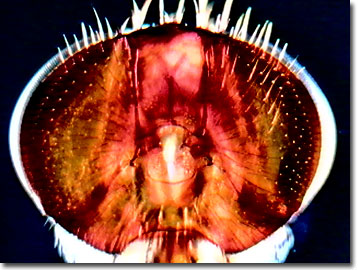Darkfield Digital Image Gallery
House Fly (Musca domestica)
The common house fly, Musca domestica, is considered to be a nuisance as well as a vector for many diseases affecting both humans and animals. From an entomologist's point of view, this dipteran is the compilation of a remarkable suite of adaptations including incredible flying speeds and agility, high-level chemosensory abilities and pressure detectors, and complex compound eyes that rival some of the military's best remote sensing devices.

View a second image of a house fly (Musca domestica).
View a third image of a house fly (Musca domestica).
House flies are among the speediest of insects with an average speed of about five miles per hour with bursts to 15 miles per hour when threatened. The rapid beating of their wings (about 1,000 times per second) is responsible for the buzzing noise that accompanies a close fly-by. The sensitive antennae of the fly are responsible for detecting both food sources and changes in air currents that signal the approach of potential predators.
Although some species of fly can bite, the house fly cannot. Its soft, spongy mouthparts are modified into the labella and proboscis. The labella gently dab liquids into its proboscis, which then sucks up the liquid. If the fly encounters suitable solid food, its enzyme-rich saliva digests the food into a liquid outside of the fly's body, which is then ingested.
Much maligned due largely to its eating habits, M. domestica consumes and contaminates just about anything and everything, using its feet to touch every potential food item to see if the taste is suitable. Fruit, sewage, candy, road kill, or rotting garbage - they're all equally delicious to a house fly. In the process of tasting everything, of course, the fly also contacts a multitude of bacteria and viruses, which can be transferred to other animals.
Flies lay up to 1,000 eggs in some of the most undesirable settings, such as garbage, decomposing plant and animal matter, feces, manure, and spoiled food. Although more abundant in the warm spring and hot summer weather, house flies may exist year-round in temperate climates, where their life cycles complete every eight days. The life span of a typical fly is about 21 days, although they can live much longer in cool weather, when their metabolism and active movement is severely reduced. The average fly is about 0.15 to 0.25 inches (about 8 millimeters) in length and they range from gray to dark brown with dark stripes on the thorax. The abdomen is colored yellow on the sides, and the eyes are often red or green. The larvae are cylindrical white maggots that average about 0.4 inches (1 centimeter) in length and taper off at the ends. Puparia are reddish-brown and are about half the size of the larvae, with the pupa forming within, and hatching in about five days.
Contributing Authors
Cynthia D. Kelly, Thomas J. Fellers and Michael W. Davidson - National High Magnetic Field Laboratory, 1800 East Paul Dirac Dr., The Florida State University, Tallahassee, Florida, 32310.
BACK TO THE DARKFIELD IMAGE GALLERY
BACK TO THE DIGITAL IMAGE GALLERIES
Questions or comments? Send us an email.
© 1995-2025 by Michael W. Davidson and The Florida State University. All Rights Reserved. No images, graphics, software, scripts, or applets may be reproduced or used in any manner without permission from the copyright holders. Use of this website means you agree to all of the Legal Terms and Conditions set forth by the owners.
This website is maintained by our
Graphics & Web Programming Team
in collaboration with Optical Microscopy at the
National High Magnetic Field Laboratory.
Last Modification Friday, Nov 13, 2015 at 01:19 PM
Access Count Since September 17, 2002: 23725
Visit the website of our partner in introductory microscopy education:
|
|
